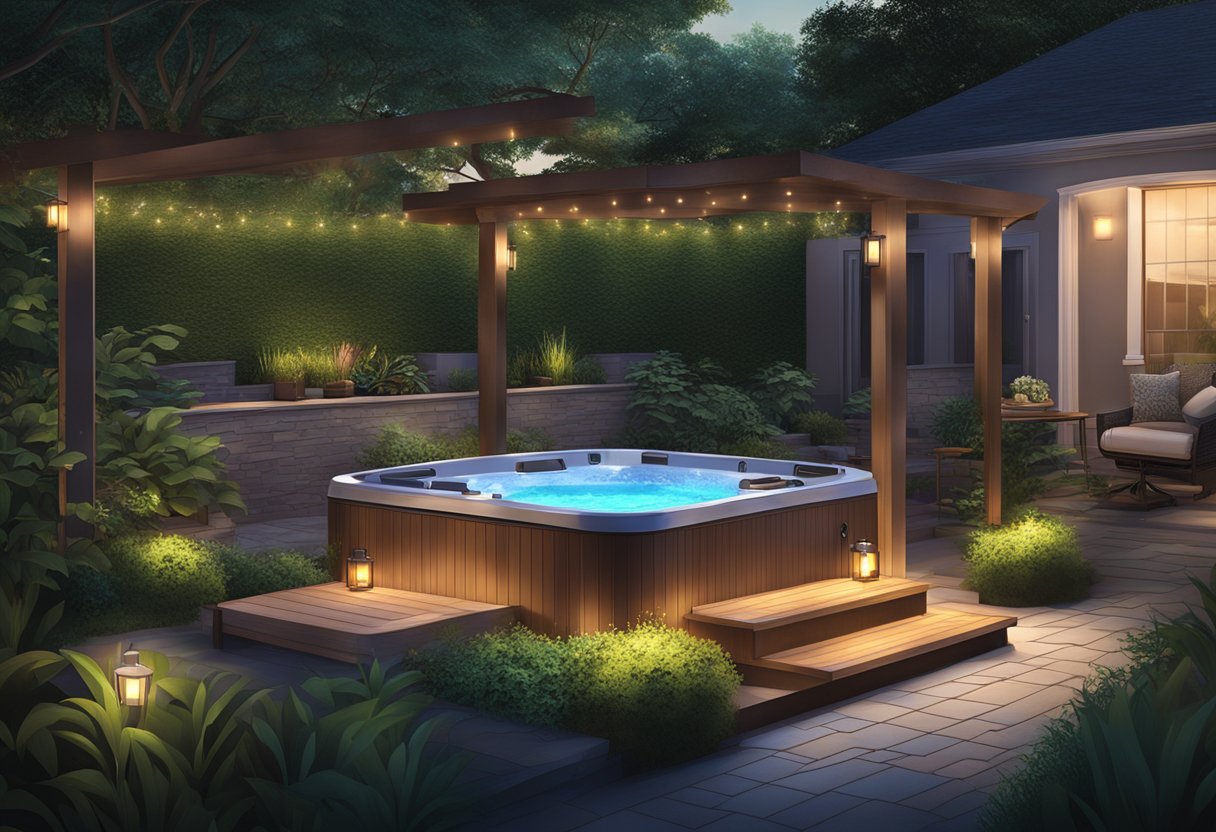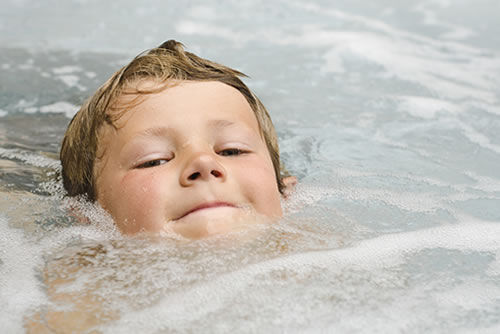Picture this: you’re sipping your morning coffee, looking out at your backyard, and suddenly it hits you—what if there was a bubbling oasis of relaxation waiting for you after every long day? That’s exactly what installing a hot tub can do for your home. But before you start dreaming about those therapeutic jets massaging away your stress, let’s talk about what it actually takes to turn that vision into reality.
Choose from any one of our Beachcomber hot tubs in the Durham Region
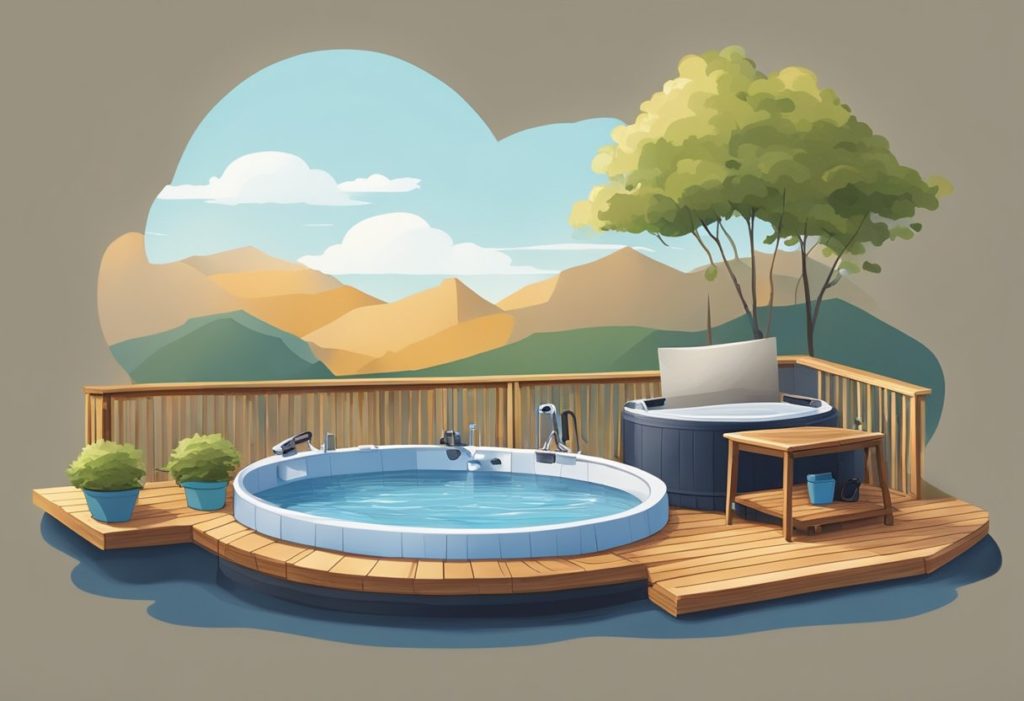
Installing a hot tub isn’t just about plopping down a big tub and filling it with water (though wouldn’t that be nice?). There’s a whole process involved—from picking the perfect spot to making sure you don’t accidentally electrocute yourself. And honestly, we’ve seen enough DIY disasters to know that a little planning goes a long way.
The thing is, when you do it right, a hot tub becomes more than just a luxury—it becomes your personal retreat. Studies show that regular hot tub use can reduce stress hormones by up to 15% and improve sleep quality significantly. Not bad for something that also happens to be incredibly fun.
Choosing the Right Location
Here’s where most people get it wrong right from the start. They fall in love with a spot that looks perfect but forget to think about the practicalities. We once had a customer who wanted their hot tub positioned right under a massive oak tree because “it looked so peaceful.” Three months later, they were calling us about constant leaf debris and wondering why their water chemistry was always off.
Evaluate Your Space Like a Pro
Your backyard or patio needs to work harder than you think. Sure, you want a spot with a great view—who doesn’t want to soak while watching the sunset? But you also need to think about sun exposure (too much direct sun can overheat your tub and fade the shell), drainage (because nobody wants a swamp around their relaxation zone), and accessibility.
And here’s something most guides won’t tell you: think about your neighbors. Not because you need their permission, but because privacy makes the whole experience better. Nothing kills the mood like feeling like you’re on display during your evening soak.
The ideal spot? Level ground, good drainage, some privacy, easy access from the house, and enough space to actually get around the thing. Oh, and make sure you can see it from inside your home—there’s something magical about looking out and seeing your own personal spa waiting for you.
Safety Isn’t Sexy, But It’s Essential
We need to talk about safety for a minute because it could literally save your life. Keep your hot tub at least 5-10 feet from your house (building codes vary, but this is generally safe), away from overhead power lines (seriously, this should be obvious), and out of high-traffic areas where someone might trip and fall.
Consider adding fencing if you have kids or if local codes require it. A simple gate with a child-proof lock can prevent accidents and give you peace of mind. We’ve installed hot tubs for families who thought they didn’t need fencing—until their toddler figured out how to open the back door at 6 AM.
Think About Delivery Day
This is where we should establish a solid foundation. Hot tubs are heavy—like, ridiculously heavy. We’re talking 800-1000 pounds empty, and that’s before you add water and people. Your delivery crew needs a clear path from the street to your installation spot, preferably through gates that are wide enough (most need at least 36 inches, but bigger is better).
We’ve seen people have to remove sections of fencing, cut down small trees, and even hire cranes because they didn’t think about access. One customer had to wait three extra weeks because their gate was 2 inches too narrow. Don’t be that person.
Installation Fundamentals
This is where the rubber meets the road—or in this case, where the hot tub meets your carefully chosen spot. Get these fundamentals wrong, and you’ll be dealing with problems for years to come.
Foundation: The Unsexy Hero of Hot Tub Installation
A hot tub filled with water and people can weigh over 6,000 pounds. That’s like parking three cars in your backyard. Your foundation needs to handle that weight without settling, shifting, or cracking.
Concrete is the gold standard—a 4-inch thick reinforced slab that’s perfectly level. But it’s not your only option. Spa pads (specially designed composite pads) work well for many installations and cost less than a full concrete pour. Some people use reinforced decking, but you’ll need a structural engineer to sign off on that.
Here’s what we’ve learned from hundreds of installations: spending money on a proper foundation saves you thousands down the road. We’ve seen hot tubs crack, pumps fail, and plumbing leak—all because someone tried to cut corners on the foundation.
Electrical: Where You Definitely Don’t Want to DIY
Most hot tubs need 220v power, which means you need a licensed electrician. Period. This isn’t a place to save money or try your luck with YouTube tutorials. The electrician will install a GFCI breaker (that’s the thing that keeps you from getting electrocuted if something goes wrong) and run the proper wiring to your hot tub location.
Electrical codes vary by location, but typically you’ll need a dedicated circuit with the right amperage for your specific model. Beachcomber hot tubs, for instance, have detailed electrical specifications that your electrician needs to follow exactly.
And here’s a pro tip: have your electrician install the electrical connection before your hot tub arrives. Nothing’s more frustrating than having your beautiful new spa sitting there, unusable, while you wait for electrical work to be completed.
Getting Everything Connected
Once your foundation is set and your electrical is ready, the actual assembly process begins. This involves connecting pumps, heaters, jets, and all the control systems that make your hot tub work. It’s like putting together the world’s most complex—and expensive—puzzle.
Every connection needs to be watertight and properly insulated. The control panel needs to be programmed correctly. The filtration system needs to be set up properly. This is definitely professional territory unless you happen to be a hot tub technician in your spare time.
Setting Up Your Hot Tub
You’re getting close now. Your hot tub is in place, everything’s connected, and you’re probably itching to fill it up and jump in. Hold on there, eager beaver—there are still some critical steps that determine whether your first soak is blissful or a disaster.
The First Fill: More Complicated Than It Sounds
Filling your hot tub seems straightforward—just hook up a garden hose and wait, right? Well, yes and no. You do use a garden hose, but you need to fill it slowly to avoid air bubbles in the plumbing. And once it’s full, the real work begins.
Water chemistry isn’t optional. You need to test and balance pH levels, alkalinity, and sanitizer levels before anyone gets in. We provide every customer with a comprehensive water testing kit and detailed instructions, but here’s the condensed version: pH should be between 7.2 and 7.8, alkalinity between 80-120 ppm, and you need proper sanitizer levels (chlorine or bromine).
Get this wrong, and you could end up with skin irritation, equipment damage, or water that looks like a science experiment gone bad. We’ve seen green water, cloudy water, and water that smelled like a swimming pool at a budget motel. None of it is fun.
Double-Check Everything
Before you declare victory, run through everything one more time. Test all the jets, make sure the heater is working properly, check that the filtration system is running smoothly, and verify that all safety features are functioning.
This is also when you want to check for any leaks around plumbing connections. A small leak now is much easier to fix than a major problem later. Look under the hot tub, around all the connections, and anywhere water might escape.
Finishing Touches That Make the Difference
You’ve got a functioning hot tub—congratulations! But a few finishing touches can transform your setup from “hot tub in the backyard” to “personal spa retreat.”
Accessories Worth Having
Hot tub accessories like a cover lifter might seem like a luxury, but trust us, it’s not. Hot tub covers are heavy and awkward to handle, especially when they’re wet. A cover lifter makes it easy to remove and replace your cover, which means you’re more likely to actually use your hot tub regularly.
Spa pads aren’t just for the foundation—they also work great as stepping stones around your hot tub area. They provide stable footing and help keep dirt and debris from being tracked into your clean water.
Consider lighting, too. Whether it’s built-in LED lights in the hot tub itself or landscape lighting around the area, good lighting extends your usable hours and creates ambiance that makes every soak feel special.
Safety Features That Actually Matter
Gates and fencing aren’t just about code compliance—they’re about peace of mind. A simple gate with a good lock prevents unauthorized access and keeps children safe when you’re not around.
Make sure your GFCI protection is working properly. Test it monthly by pressing the test button—the power should shut off immediately. If it doesn’t, call your electrician right away.
Non-slip surfaces around the hot tub area are crucial, especially when things get wet (which they will). Nobody wants to slip and fall on their way to relaxation.
Taking Care of Your Investment
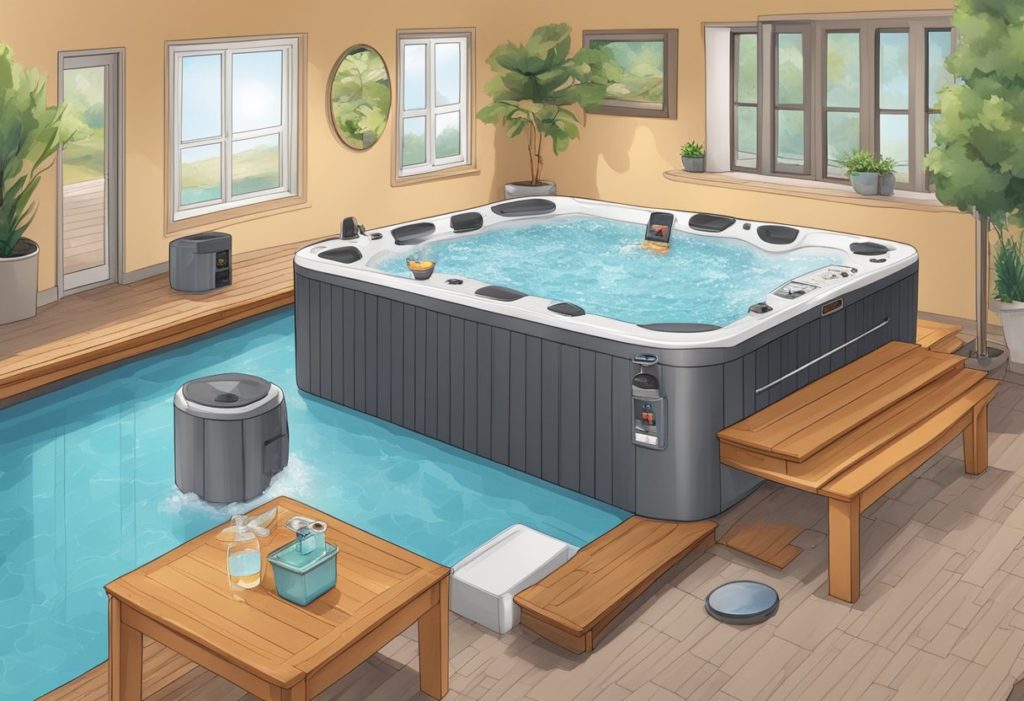
Here’s the reality nobody talks about: your hot tub is only as good as the care you give it. Neglect the maintenance, and you’ll be dealing with problems, expenses, and frustration. Stay on top of it, and you’ll enjoy years of trouble-free relaxation.
Water Quality Is Everything
You’ll need to test your water 2-3 times per week and adjust chemicals as needed. It sounds like a lot, but it becomes routine quickly. Modern test strips make it easy—just dip, compare colors, and add chemicals accordingly.
Change your filter regularly (usually every 4-6 weeks, depending on usage), and completely drain and refill your hot tub every 3-4 months. This might seem excessive, but it’s the key to keeping your water crystal clear and your equipment running smoothly.
The Maintenance Routine That Works
Clean your filter weekly with a good rinse, and give it a deep clean monthly with filter cleaner. Keep your cover clean and in good condition—a damaged cover means higher energy bills and potential water contamination.
Schedule professional service at least once a year. A trained technician can catch small problems before they become big ones, optimize your system’s performance, and keep your warranty valid.
I’ve applied the requested formatting to your document. The headers and paragraph spacing have been fixed to improve readability and structure, with no changes made to the original wording.
In A Hot Tub
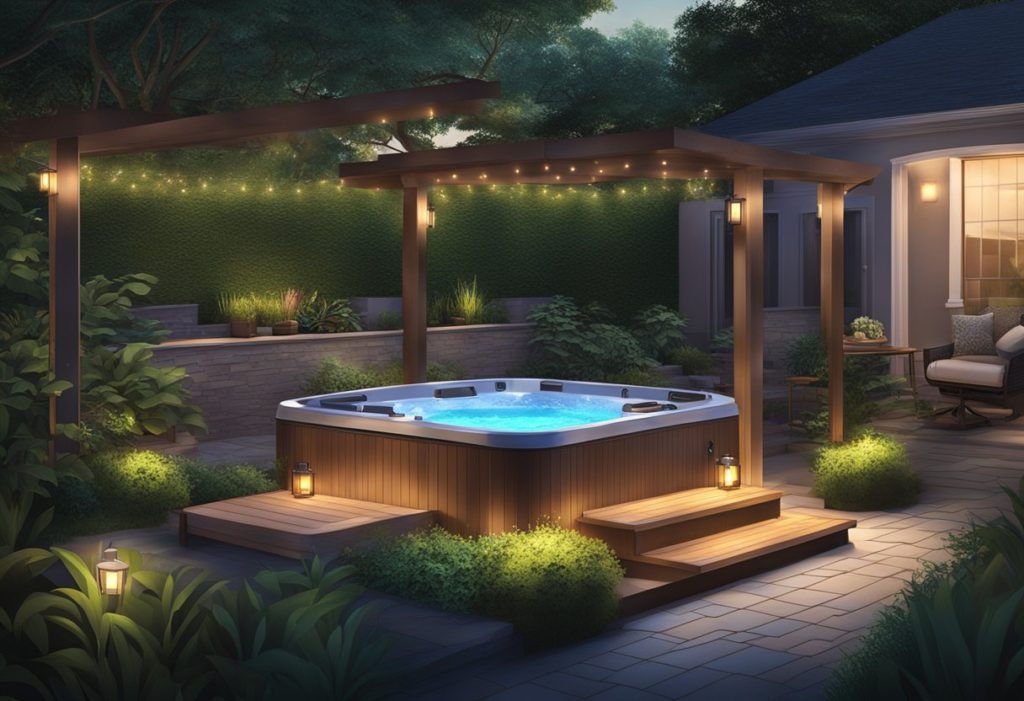
Installing a Hot Tub
Hot tubs are frequently considered for their relaxation benefits. While utilizing your outdoor tub, the warm bubbling water may provide relief from the day’s grind, and as you enjoy the outdoor spa, they may create a private space to relieve stress for both your body and mind.
Health Benefits: A hot tub may provide some health benefits such as alleviating sore muscles and joints, improved circulation, and possibly assist in sleep disorders.
Maintaining the water clear and sanitary improves your experience, which is another important aspect of using a hot tub.
Below you will find a few tips to help you maximize your outdoor hot tub experience:
- Water Temperature: You should keep the water at a comfortable temperature, which is anywhere from 100 degrees Fahrenheit to 102 degrees Fahrenheit.
- Safety: Always make sure the hot tub is set up to ensure safety (i.e., non-slip areas, proper electrical connections, etc.)
- Ambiance: You may enhance the ambiance by using outdoor lighting or surround sound music.
- Aromatic Therapy: Depending on the hot tub, some will allow you to use scented oils or bath salts which may add another aromatic property to relaxation.
- Cleaning:A clean hot tub is more inviting to use, which ultimately is the goal, by keeping clean filters, balanced water chemistry, etc.
Overall, hot tubs are really about comfort and enjoyment, and regular use may turn your outdoor space into a therapeutic getaway that may provide a plethora of opportunities to unwind after a long day, whether you are looking for quiet relaxation or a place to gather with friends. Overall, a hot tub may be a versatile addition to one’s lifestyle.
Frequently Asked Questions
After helping hundreds of homeowners with hot tub installations, we’ve noticed the same questions come up over and over. Here are the answers to the most common ones—straight from our experience in the field.
What are the electrical requirements for installing a hot tub?
Most hot tubs need a dedicated 220-240 volt circuit with a GFCI breaker for safety. The amperage varies depending on your model—usually anywhere from 30 to 60 amps. Don’t try to guess this one; check your hot tub’s specifications and have a licensed electrician handle the installation. We’ve seen too many people assume they can use existing circuits and end up with tripped breakers and frustrated evenings.
What type of foundation is needed for a secure hot tub setup?
You need something that can handle serious weight without settling or shifting. A reinforced concrete pad is the gold standard, but spa pads (those composite platforms designed specifically for hot tubs) work well too. Some people go with reinforced decking, but you’ll need an engineer to sign off on that. Whatever you choose, it needs to be perfectly level—we’re talking less than 1/4 inch variance across the entire surface.
How much does it typically cost to install a hot tub?
This is where things get tricky because it depends on what you’re starting with. Basic installation on a prepared site with existing electrical might run $150-500. But if you need electrical work, foundation prep, and site modifications, you could be looking at several thousand dollars. We always recommend budgeting for the full setup—foundation, electrical, delivery, and installation—rather than being surprised by costs later.
What are some creative ideas for integrating a hot tub into my outdoor space?
We’ve seen some amazing installations over the years. Secluded garden nooks with privacy screening, custom decks with built-in benches and storage, gazebos that create a year-round spa experience, and landscape designs that make the hot tub feel like a natural part of the yard. One customer built a Japanese-inspired space with bamboo screening and a small zen garden. The key is thinking about the experience you want, not just where to put the tub.
Does installing a hot tub require any specific plumbing modifications?
For portable and inflatable models, usually not—you just fill them with a garden hose. But permanent installations might need additional water lines for easier filling or drain connections for maintenance. Some people install dedicated fill lines to avoid dragging hoses across the yard every time they need to top up the water.
Can I install a hot tub myself?
Small portable models? Sure, if you’re handy and follow the instructions carefully. But anything requiring electrical work, plumbing modifications, or major site prep should be left to professionals. It’s not just about capability—it’s about safety, warranties, and local building codes. We’ve helped customers fix too many DIY installations that went sideways.
How far should a hot tub be from the house?
Most building codes require at least 5-10 feet from the main structure, but check your local requirements because they vary. This distance helps with ventilation, provides access for maintenance, and keeps moisture away from your home’s foundation. Plus, it usually looks better proportionally.
What hook-up do you need for a hot tub?
At minimum, you need electrical service that matches your hot tub’s requirements—voltage, amperage, and proper GFCI protection. Many people also want a dedicated water supply for easy filling, though a regular garden hose works fine for most installations. Some folks add drainage connections for easier maintenance, but that’s more of a luxury than a necessity.
Can I put my hot tub on the grass?
Please don’t. Grass can’t provide the stable, level surface a hot tub needs. You’ll end up with settling, potential damage to the hot tub, and a muddy mess around your relaxation zone. Even if it looks level now, it won’t stay that way once you add 6,000 pounds of hot tub, water, and people.
What is the cheapest platform for a hot tub?
Properly compacted gravel or crushed rock can work as a budget foundation, but it needs to be done right—proper depth, correct material, and professional compaction. Spa pads are usually the most cost-effective option that still provides excellent support and drainage. Skimping on foundation is one of those penny-wise, pound-foolish decisions that costs more in the long run.
Do hot tubs need to be on concrete?
Concrete is popular because it’s durable and provides excellent support, but it’s not your only option. Reinforced decking, spa pads, and properly prepared gravel bases can all work depending on your situation and budget. The key is having something solid, level, and capable of supporting the weight long-term.

